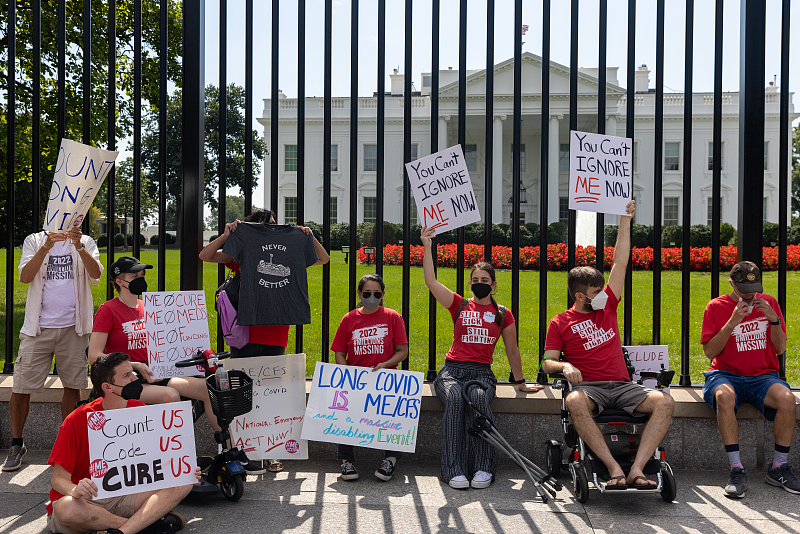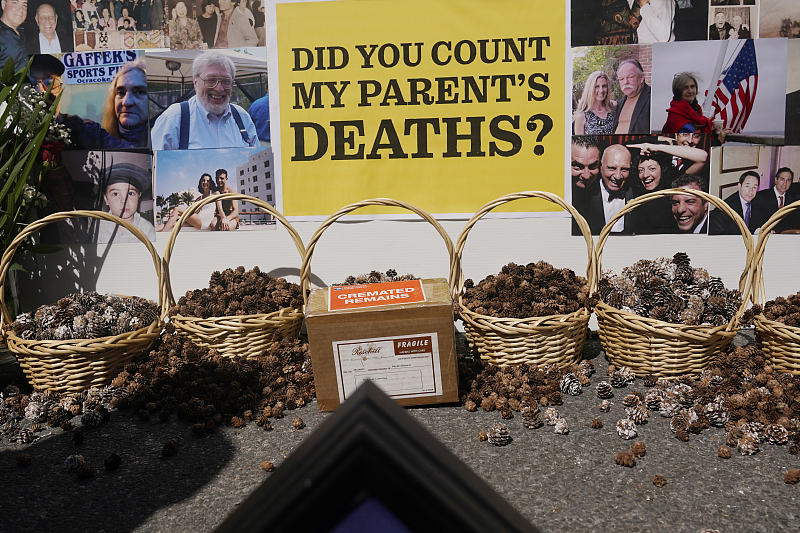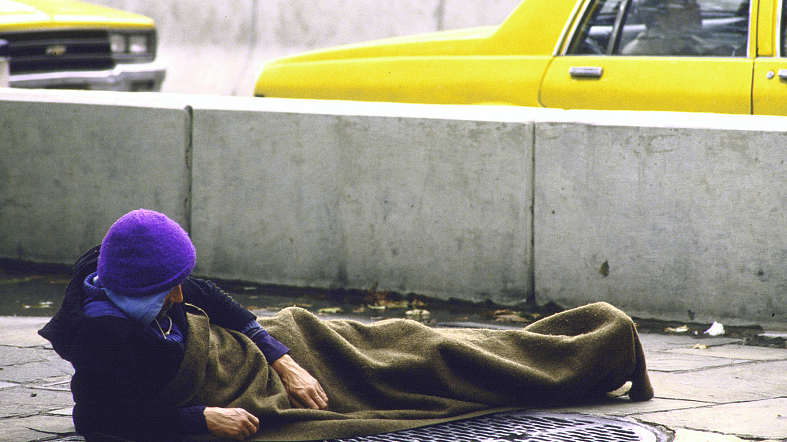
Protestors chant outside the White House to call attention to those suffering from Myalgic Encephalomyelitis and long COVID in Washington, D.C., U.S., on September 19, 2022. /CFP
Protestors chant outside the White House to call attention to those suffering from Myalgic Encephalomyelitis and long COVID in Washington, D.C., U.S., on September 19, 2022. /CFP
The U.S. government is ignoring "the greatest mass-disabling event in human history," Time magazine reported, quoting long COVID experts and advocates.
In a July Axios-Ipsos poll, 17 percent of people said their biggest fear related to COVID-19 is the possibility of getting long COVID, a potentially disabling condition in which symptoms linger or emerge well after an acute infection, according to the report published by Time magazine on Monday.
"But at a time when the majority of U.S. adults think there's little risk in returning to normal, mask wearers, test takers, and social distancers walk a lonely road," said the report.
Throughout 2022, the U.S. Centers for Disease Control and Prevention (CDC) has rolled back many of its recommended COVID-19 precautions.
CDC guidance no longer recommends social distancing, mask-wearing, or screening tests for most people who do not have symptoms, and unvaccinated people do not need to quarantine if they are exposed to the virus, according to the report.
"But even with high levels of population immunity, long COVID cases continue to pile up. By the CDC's own estimate from June, one in five U.S. adults with a known prior case of COVID-19 had symptoms of long COVID," said the report.

Pinecones representing the people who died from COVID-19 in nursing homes surround the ashes of Dnynia Armstrong, a nursing home resident that died from COVID-19, during a news conference in New York, U.S., March 21, 2021. /CFP
Pinecones representing the people who died from COVID-19 in nursing homes surround the ashes of Dnynia Armstrong, a nursing home resident that died from COVID-19, during a news conference in New York, U.S., March 21, 2021. /CFP
Officials not doing enough, 18 million American adults estimated to have long COVID
In a recent study, titled "The epidemiology of long COVID in U.S. adults two years after the start of the U.S. SARS-CoV-2 pandemic," posted to the medRxiv, the preprint server for Health Sciences, it found that some 18 million adults in the United States have long COVID.
"Using a population-representative sample of adults living in the U.S., we estimate that approximately 18.5 million adults, 7.3 percent of the U.S. adult population, was experiencing long COVID during the two-week study period in June-July 2022," it said.
Health officials are not doing enough to prevent transmission of the virus and help people understand its risks, said Kristin Urquiza, who founded the advocacy group Marked By COVID after her father died from the virus in 2020.
"Leaders have thrown their hands up in the air and basically said, 'You do you,'" she was quoted as saying.

A homeless person in New York City, U.S. /CFP
A homeless person in New York City, U.S. /CFP
Long COVID keeps 2-4 million Americans out of workforce
Long COVID-19, with symptoms lasting three or more months, faced by millions of Americans, is creating problems for both businesses and employees.
According to the U.S. Census Bureau, around 16 million working-age Americans have long COVID. Of those, 2-4 million are out of work due to long COVID, noted Katie Bach, a nonresident senior fellow at the Brookings Institution.
Lost wages amount to around $170 billion a year, and "these impacts stand to worsen over time if the United States does not take the necessary policy actions," Bach wrote in an analysis.
A study by the Federal Reserve Bank of Minneapolis also found that nearly 26 percent of those with long COVID have had an impact on their work, either rendering them unemployed or reducing their hours.
Britain's Trades Union Congress, meanwhile, found that 20 percent of people with long COVID were not working, and an additional 16 percent were working reduced hours, Bach noted.
A study from the medical journal The Lancet also found that 22 percent of people with long COVID were not able to work, and 45 percent had to cut their working hours.
David Cutler, an economics professor at Harvard University, recently estimated that the total cost of long COVID is 3.7 trillion dollars. Nearly 60 percent of the cost, or $2.2 trillion are lost quality of life; the remainder is reduced earnings ($one trillion) and greater medical spending ($528 billion).
The post-pandemic labor force participation rate, the rate at which people are in the workforce, remains low, and long COVID may be a contributing factor, said Barry Bosworth, senior fellow at the Brookings Institution.
Bach argued what is needed is more accessible prevention and treatment options, among other things. But even with more options, individuals will continue to get infected, and some will acquire long COVID.
Recently, the White House released its National Research Action Plan on Long COVID-19, while Congress appropriated $1.15 billion for funding the National Institutes of Health, to study long COVID.
(With input from agencies)

